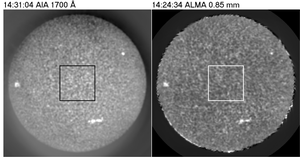Solar System and Planetary Science
The NRAO facilities worked in concert with deep space probes and other ground-based facilities to study the physics and chemistry of objects in the Solar System.
Oort-cloud comet C/2014 UN271 (Bernardinelli-Bernstein) was discovered at ~29 AU from the Sun (Lellouch et al. 2022 A&A 659, 1L), developing cometary activity early with a brightness suggesting a large size. ALMA detected thermal emission when the comet was at 20 AU distance from the Sun, from which a surface-equivalent diameter of 137 km is calculated. It is thus the largest Oort-cloud object ever found, (almost twice as large as comet C/1995 O1 Hale-Bopp) and has a normal cometary albedo. Detection of gases is expected in the upcoming years as the comet heads toward a perihelion of 11 AU in 2031.

Allisandrakis et al. (2022, A & A, 661, L4) present the first full-disk Solar images (Figure 3) obtained with ALMA, using Band 7 (0.86 mm; 347 GHz). The results show a disk practically devoid of active regions at their 21" resolution. Solar structures on the disk are similar to those in Atmospheric Imaging Assembly images at 1600 Å and 304 Å; they are also similar to negative Hα images of equivalent resolution. Small plage regions are about 900K brighter than their surroundings, while the polar coronal holes and small Ha filaments are not detectable. The authors deduced a brightness temperature at the center of the disk of 6085 K at 0.85mm, rather than the 5500 K extrapolated from images at 3mm and 1.3mm, an indication that at 0.85mm we are approaching the temperature minimum.
With the ever-increasing number of known exoplanets, many in the habitable zone, understanding the effects of stellar activity (exospace weather), on the potential development of life has become paramount. ALMA, working in concert with a multi-wavelength arsenal of space and ground-based telescopes, has measured the faintest flare to date on the nearby (1.2pc distance) M dwarf star, Proxima Centauri, which hosts a planet in the habitable zone (Howard et al. 2022). The X-ray flare is well within the luminosity range of typical flares on the Sun, while the millimeter emission is two orders of magnitude stronger than typical Solar flares. The findings provide more evidence that millimeter emission is a common feature in weak exo-stellar flares, rising and falling in timescales of seconds. The implied temperature for the corona is 1.1x107 K.




Connect with NRAO